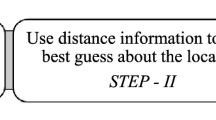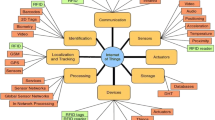Abstract
In this work, we investigate distributed decision fusion in hierarchical wireless sensor networks that are degraded by fading and noise. With the use of the complete fading channel state information (CSI), we first derive the likelihood ratio test (LRT) based optimum fusion rule, which we call LRT–CSI. Then, we relax the use of the complete CSI and only the exact phase information is employed together with channel envelope statistics (CS), and we develop another LRT based fusion rule named LRT–CS, which is computationally simpler to implement compared to LRT–CSI. Finally, we analyze the detection performance of all the proposed fusion rules through extensive numerical results.







Similar content being viewed by others
Notes
Although we have assumed clusters with equal size K, the expressions and derivations are still same for the case of clusters with different sizes. Specifically, it is enough to replace K with K m , which denotes the size of the mth cluster.
References
Akyildiz, I. F., Su, W., Sankarasubramaniam, Y., Cayirci, E. (2002). A survey on sensor networks. IEEE Communications Magazine, 102–114.
Varshney, P. K. (1997). Distributed detection and data fusion. New York: Springer.
Tenney, R. R., & Sandell, N. R, Jr. (1981). Detection with distributed sensors. Transactions Aerospace and Electronic Systems, AES-17, 501–510.
Hoballah, I. Y., & Varshney, P. K. (1989). Distributed Bayesian signal detection. IEEE Transactions on Information Theory, 35, 995–1000.
Thomopoulos, S. C. A., Viswanathan, R., & Bougoulias, D. K. (1989). Optimal distributed decision fusion. IEEE Transactions on Aerospace and Electronic Systems, 25, 761–765.
Chair, Z., & Varshney, P. K. (1986). Optimal data fusion in multiple sensor detection system. IEEE Transactions on Aerospace and Electronic Systems, 22, 98–101.
Tang, Z. B., Pattipatti, K., & Kleinman, D. L. (1991). An algorithm for determining the detection thresholds in a distributed detection problem. IEEE Transactions on Systems, Man and Cybernetics, 21, 231–237.
Helstrom, C. W. (1995). Gradient algorithms for quantization levels in distributed systems. IEEE Transactions on Aerospace and Electronic Systems, 31, 390–398.
Lauer, G. S., & Sandell, N. R. (1982). Distributed detection of known signal in correlated noise. Burlington: Rep. ALPHATECH.
Aalo, V., & Viswanathan, R. (1989). On distributed detection with correlated sensors: Two examples. IEEE Transactions on Aerospace and Electronic Systems, 25, 414–421.
Kam, M., Chang, W., & Zhu, Q. (1991). Hardware complexity of binary distributed detection systems with isolated local Bayesian detectors. IEEE Transactions on Systems, Man and Cybernetics, 21(3), 565–571.
Drakopoulos, E., & Lee, C. C. (1991). Optimum multisensor fusion of correlated local decisions. IEEE Transactions on Aerospace and Electronic Systems, 27(4), 593–605.
Kam, M., Zhu, Q., & Gray, W. S. (1992). Optimal data fusion of correlated local decisions in multiple sensor detection systems. IEEE Transactions on Aerospace and Electronic Systems, 28(3), 916–920.
Willett, P. K., Swaszek, P. F., & Blum, R. S. (2000). The good, bad, and ugly: Distributed detection of a known signal in dependent Gaussian noise. IEEE Transactions on Signal Processing, 48(12), 3266–3279.
Rago, C., Willett, P. K., & Bar-Shalom, Y. (1996). Censoring sensors: A low-communication-rate scheme for distributed detection. IEEE Transactions on Aerospace and Electronic Systems, 32(2), 554–568.
Yu, C. T., & Varshney, P. K. (1998). Paradigm for distributed detection under communication constraints. Optical Engineering, 37(2), 417–426.
Gini, F., Lombardini, F., & Verrazzani, L. (1998). Decentralised detection stratigies under communication constraints. in Proceedings of the Institute of Electical Engineering, Part F: Radar, Sonar, Navigation, 145, 199–208.
Chamberland, J., & Veeravalli, V. V. (2003). Decentralized detection in sensor networks. IEEE Transactions on Signal Processing, 51(2), 407–416.
Appadwedula, S., Veeravalli, V. V., & Jones, D. L. (2002). Robust and locally-optimum decentralized detection with censoring sensors. Fifth International Conference on Infomiation Fusion, Proceedings, 1, 5643.
Thomopoulos, S. C. A., & Zhang, L. (1992). Distributed decision fusion with networking delays and channel errors. Information Sciences, 66, 91–118.
Chen, B., & Willet, P. K. (2005). On the optimality of the likelihood-ratio test for local sensor decision rules in the presence of nonideal channels. IEEE Transactions on Information Theory, 51(2), 693–699.
Chen, B., Jiang, R., Kasetkasem, T., & Varshney, P. K. (2004). Channel aware decision fusion in wireless sensor networks. IEEE Transactions on Signal Processing, 52(12), 3454–3458.
Niu, R., Chen, B., & Varshney, P. K. (2006). Fusion of decisions transmitted over Rayleigh fading channels in wireless sensor networks. IEEE Transaction on Signal Processing, 54(3), 1018–1027.
Tian, Q., & Coyle, E. J. (2007). Optimal distributed detection in clustered wireless sensor networks. IEEE Transactions on Signal Processing, 55(7), 3892–3904.
Ferrari, G., Martalo, M., & Pagliari, R. (2011). Decentralized detection in clustered sensor networks. IEEE Transactions on Aerospace and Electronic Systems, 47(2), 959–973.
Tsitsiklis, J. N. (1993). Decentralized detection. Advances in Statistical Signal Processing, 2, 297–334.
Lin, Y., Chen, B., & Varshney, P. K. (2005). Decision fusion rules in multi-hop wireless sensor networks. IEEE Transactions on Aerospace and Electronic Systems, 41, 475–488.
Proakis, J. G. (2001). Digital communications (4th ed.). New York: McGraw-Hill.
Press, W. H., Teukolsky, S. A., Vetterling, W. T., & Flannery, B. P. (1997). Numerical recipes in C. New York: Cambridge University Press.
Ye, N. (Ed.). (2003). The handbook of data mining. Lawrance Erlbaum Associates.
Author information
Authors and Affiliations
Corresponding author
Rights and permissions
About this article
Cite this article
Eritmen, K., Keskinoz, M. Distributed decision fusion over fading channels in hierarchical wireless sensor networks. Wireless Netw 20, 987–1002 (2014). https://doi.org/10.1007/s11276-013-0649-y
Published:
Issue Date:
DOI: https://doi.org/10.1007/s11276-013-0649-y




